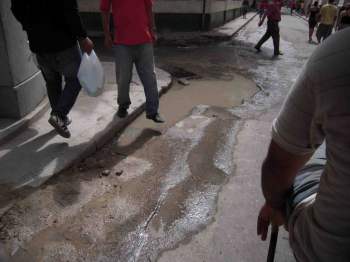The priority of tyrants is always to perpetuate their hold on power, and never the well-being of a nation’s citizens who are viewed as merely chattel at their disposal. (Here and here) This is as true in Cuba as it was in Stalinist Russia, or in North Korea today. Tyrants build or tear down or neglect to satisfy the whims of this need. The Castro’s focus has been on tearing down and destroying all reminders of everything that they cannot themselves take credit for, honestly or otherwise. Co-op Jose Marti for the revolution, easy propaganda, the beautiful buildings and high standard of living thanks to previous governments, no…
Enter Cuba’s water crisis, setting the stage for the current Cholera epidemic. The deterioration of Cuba’s water infrastructure has been documented by many sources over the years; here are a few links relevant to the problem of Cholera.
Autentico. org: The water and sewer system in the main urban areas of Cuba have not received any major maintenance in over 25 years. The average age of these systems is over 60 years. Consequently, there is contamination of the drinking water in most main urban areas due to the mixing of drinking water and sewer waste through the transmission pipes. There is a constant deposit of sewage in the streets of most main urban areas of Cuba.
LA Times: Neglected for more than four decades, Havana is rife with imperfections: Sewage runs in the streets; water pipes won’t work; abandoned structures, some converted into slum housing, collapse overnight. Thomas Paul, a Tucson fireman/paramedic visiting with the Global Exchange group, said much of the city would be condemned if it were in the U.S.
CubaNet: An open sewer about three blocks long has become a breeding ground for mosquitoes and disease in Batabanó, south of Havana. For the last 11 months, residents of Las Biplantas in the municipality have been petitioning authorities to correct the spillage of black water coming from the buildings on 68 and 77 Streets.
“The pumping system is broken, and the water ends up being discharged on the streets. We are practically swimming in them,” said one young man in the neighborhood.Moon Travel: Cuba is a tropical country and the health hazards are many: filthy public fixtures, garbage rotting in the streets, polluted watercourses, broken sewer pipes, holes in sidewalks, dilapidated buildings, and so on…
The average Cuban lives with contaminated water from leaking plumbing running in the streets, reduced water flow available in their homes — that is if they are the lucky ones who have any running water. The rest are forced to carry their water supply home in buckets.
Update: More (in Spanish) Oscar Haza, Falta De Agua En La Habana via gusanomarielito:

